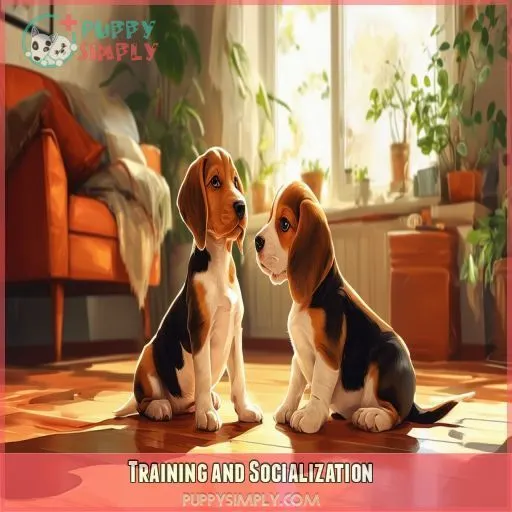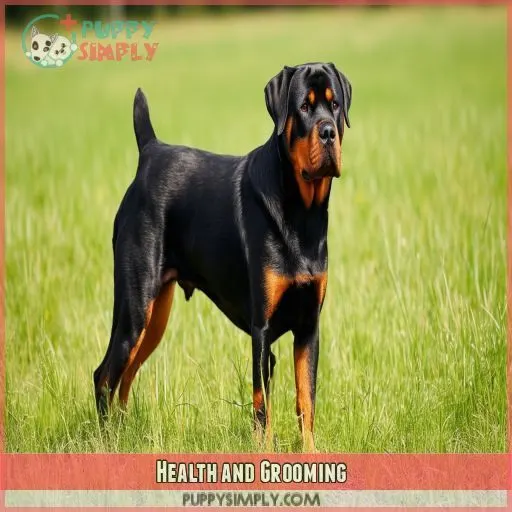This site is supported by our readers. We may earn a commission, at no cost to you, if you purchase through links.

These dogs have worked as good watchdogs, efficient herders, or even cart-pullers throughout history. Today, they don’t just remain great family pets but also serve as therapy dogs and dog sporting enthusiasts.
Uncover the breed’s rich heritage and the traits that make Rottweilers such versatile and valued canines
Table Of Contents
- Key Takeaways
- What Are Rottweilers Bred For?
- Ancient Origins
- Original Purpose
- Evolution of Roles
- Decline and Revival
- Modern Roles
- Characteristics
- Training and Socialization
- Family Compatibility
- Health and Grooming
- Popularity and Recognition
- Frequently Asked Questions (FAQs)
- What is the purpose of a Rottweiler?
- What were Rottweilers originally bred for?
- What will Rottweilers bred for?
- What two dogs create a Rottweiler?
- Why were Rottweilers bred?
- What do Rottweilers like to do?
- Why should you choose a Rottweiler dog breed?
- Is a Rottweiler a popular dog breed?
- Are Rottweilers good with cats and other pets?
- How much exercise does a Rottweiler need daily?
- Do Rottweilers drool a lot?
- What is the average lifespan of a Rottweiler?
- Are Rottweilers prone to separation anxiety?
- Conclusion
Key Takeaways
- Rottweilers are a versatile breed with a rich history, bred for herding, protection, and companionship.
- From their ancient roots as Roman Mastiffs to their modern roles in therapy and dog sports, Rottweilers have proven to be loyal, hardworking companions.
- Their strong temperament, intelligence, and adaptability make them a valuable breed to this day.
- If you’re looking for a loyal, protective, and versatile companion, a Rottweiler might be the perfect breed for you
What Are Rottweilers Bred For?
Rottweilers were originally bred for herding livestock and guarding properties, tracing their lineage to Roman mastiffs that accompanied legions across Europe.
Known as "butchers’ dogs" in Rottweil, Germany, they excelled in driving cattle to market and protecting farms.
As industrialization changed the landscape, these versatile dogs adapted to new roles like police work, cart pulling, and loyal household companions.
Today, they’re valued for therapy work, competitive dog sports, and even modern herding tasks.
Their calm, confident, and courageous temperament makes them excellent guardians and devoted friends.
Want to discover more about these remarkable dogs and their rich history? Keep going!
Ancient Origins
Rottweilers can be tracked as far back as the Roman mastiffs that followed the legions throughout Europe. These original dogs were bred for herding and guarding the Roman armies in their conquests—the foundation for such a multi-purpose breed today.
Roman Mastiffs
You may be surprised to know that the ancestors of Rottweilers were Roman mastiffs. The breed of these mighty dogs accompanied legions into Switzerland, where they’d become part of the foundation that formed this breed as we know it today.
In Rottweil, a town in the southwestern region of Germany, these ancient working dogs earned their laurels as "butchers’ dogs," an epitome of strength and acumen.
Their Schutzhund background has set a foundation for the all-round Rottweilers we admire today
Herding and Protection
As the Roman legions conquered most of Europe, their mastiff-like dogs became proficient herders and supporters. You’ll see the early Rottweilers tirelessly at work with drovers, guarding their livestock and defending farms—their instincts to protect carried over well in service to home security as well.
Though today’s Rottweilers aren’t herding sheep, that innate drive for guardianship doesn’t go away. That’s why obedience classes and puppy training are necessary in channeling that protective nature properly
Original Purpose
Rottweilers were originally bred for two primary purposes: herding livestock and guarding properties. These powerful dogs excelled at driving cattle to market and protecting farms and businesses, making them invaluable companions for butchers and farmers in the town of Rottweil, Germany
Herding Livestock
You will learn that the history of Rottweilers as herding dogs has fashioned their nature and abilities. These athletic dogs were adept at herding stock, specifically working cattle. Their early employment in herding was part of the breed’s survival and helped to build their devoted, protective nature.
Socialization problems that occurred with Rottweilers during the time they were herding stock created some characteristic ways of interacting with other animals.
Their family-oriented natures and grooming needs today reflect this rich history of herding
Guarding Properties
While Rottweilers excelled at herding, their protective instincts made them natural guardians too. You’ll find these powerful pups took their watchdog duties seriously, earning the nickname "Rottweiler Metzgerhund" or butcher’s dog.
They’d keep a keen eye on livestock and property, deterring intruders with their imposing presence.
Today’s German Rottweilers still shine in property protection, channeling their ancestral guarding prowess to keep your family safe and sound
Evolution of Roles
As industrialization reduced the need for herding dogs, Rottweilers adapted to new roles in society. You’ll find that they became valuable as police dogs, strong cart-pullers for workers, and loyal household companions, showcasing their versatility and intelligence
Police Dogs
You’ll find Rottweilers excelling as police dogs, thanks to their impressive strength and unwavering loyalty. These natural protectors have a knack for public safety, often outshining German Shepherds and Doberman Pinschers in police training.
Their sharp tracking skills and protective instincts make them invaluable service animals. The AKC recognizes Rottweilers’ prowess in law enforcement, where they serve as the ultimate guardians, sniffing out danger and keeping communities safe
Cart Pulling
While Rottweilers excelled in police work, their strength and endurance made them ideal for cart pulling, too. Times changed, but such strong dogs found a new niche in hauling goods for workers. This didn’t just prove how physically strong they were but also revived the breed’s popularity.
You’ll find that Rottweilers find use in many other areas besides police work, for example, as therapy animals and in family settings as pets
Household Companions
You’ll find Rottweilers make excellent household companions, adapting seamlessly from their working roots to become loyal family members. These gentle giants offer more than just protection; they’re furry therapists in disguise. Here’s why Rottweilers shine as companions:
- Unwavering loyalty to their human pack
- Natural protective instincts, keeping your home safe
- Excellent with children when properly socialized
- Adaptable to various living situations
- Potential for therapy work and service roles
Decline and Revival
The Industrial Revolution severely impacted Rottweilers, as railroads replaced their traditional roles in herding and protecting livestock. Dedicated fanciers worked tirelessly to preserve the breed through selective breeding, ensuring the Rottweiler’s survival and eventual revival as a versatile working dog
Impact of Industrial Revolution
The dramatic change you’d see in what Rottweilers do is where transportation evolved. It hit hard on these versatile dogs through the impact of industrial revolutions. With railroads snubbing traditional methods, demand plummets for breeds. How the Industrial Revolution affected Rottweilers:
| Aspect | Impact |
|---|---|
| Population | Steep decline |
| Demand | Decreased significantly |
| Roles | Moved from herding to other duties |
| Appearance | Probably changed through artificial selection |
Breed standard
This shift made breeders recommit themselves to thinking about what the Rottweilers were bred for and founded new roles with challenges.
Breed Preservation
You will find that dedicated enthusiasts played a crucial role in the survival of this breed of dog. Enthusiasts were able to continue passing on, through selective breeding, those characteristics that made Rottweilers such an asset.
Breed clubs formed, promoting international recognition and ensuring genetic diversity. Though less famous compared to the Siberian Husky or perhaps the Leonberger Club, the Rottweiler enthusiasts never gave up and continually forged on in their efforts to keep the breed surviving to answer: "What are Rottweilers bred for?"
Their work ensured that this breed wasn’t relegated to oblivion like that of the rare Weiler Dane
Modern Roles
Rottweilers have found new roles as therapy dogs, providing comfort and support in various settings. You’ll also see these versatile dogs excelling in competitive sports like agility, tracking, and obedience trials
Therapy Work
You’ll be amazed at how Rottweilers shine as therapy dogs. These gentle giants have a knack for bringing comfort to those in need. From hospital visits to elderly care, Rotties excel in providing emotional support. Their calm demeanor and intuitive nature make them ideal companions for people with special needs.
- Bring smiles to patients during hospital visits
- Offer a comforting presence in elderly care facilities
- Provide emotional support for individuals with anxiety or depression
- Assist in special needs programs, helping children with developmental challenges
Dog Sports
Besides therapy work, Rottweilers have genuinely excelled in dog sports.
The only thing that will get these gentle giants to be overwhelmed is powerful agility courses, where they weave through obstacles with fantastic grace. With their keen noses, they do well in tracking and search and rescue operations.
One wouldn’t be surprised to find a Rottweiler herding sheep or sniffing out narcotics. Such versatile dogs prove that brawn and brains make an unbeatable combination in canine athletics
Characteristics
Rottweilers are known for their calm, confident, and courageous temperament, which makes them excellent guardians and loyal companions. While generally healthy, they’re prone to certain health issues like hip dysplasia and hypothyroidism, so regular veterinary check-ups are essential for their well-being
Temperament
You’ll find Rottweilers to be a fascinating blend of strength and gentleness. Their temperament is characterized by:
- Calm confidence
- Unwavering courage
- Deep affection for family
These powerful pups are known for their protective nature, acting as vigilant guardians of their loved ones. While they may seem aloof with strangers, you’ll discover a softer side when they’re with their family. They’re like gentle giants, ready to shower you with love while keeping a watchful eye on your safety
Health Concerns
Even though Rottweilers are generally robust, they can still develop some health-related problems.
Look out for hip and elbow dysplasia—severe issues for their mobility—and hypothyroidism, which reduces their activity levels.
Von Willebrand’s disease can potentially cause problems with bleeding. Osteosarcoma is a type of bone cancer that can affect Rottweilers.
Given these potential health issues, regular check-ups with your vet will be vital to keep your Rottweiler in top condition
Training and Socialization
Since Rottweilers have protective instincts and muscular bodies, training and socialization are very important. You’ll need to start very early with steady obedience training and make sure that it’s socialized with many people, animals, and places so that it will grow up into a polite, confident adult.
Importance of Training
Training is essential for your Rottweiler and your peace of mind. You have a powerful dog that needs firm guidance to be a well-mannered companion. Here’s why training matters:
- Prevents behavioral issues and aggression
- Strengthens the bond between you and your dog
- Keeps your Rottie safe in different situations
Begin with basic obedience classes and work upwards into the most advanced training. The key to a Rottweiler is consistency more than anything else. Then, you have the reward of a loyal, disciplined companion.
Socialization Techniques
Though the training of your Rottweiler is of much importance, their socialization is still considered to be of equal value. Early exposure to various people, animals, and places is necessary from a very early stage while they’re still pups.
Apply positive reinforcement methods to encourage good behavior on the part of your Rottie. Study the temperament of your Rottie and then decide on the socialization technique. Consider the kind of family background a dog comes from while introducing new experiences to them.
As you can see, a well-socialized Rottweiler tends to show its breed at its best, adjust to situations quickly, and display its roguish charm with élan
Family Compatibility
When considering a Rottweiler for your family, you’ll need to understand their compatibility with children and other pets. Rottweilers typically get along well with kids, especially when raised together, but they should always be supervised around young children and may have issues with unfamiliar dogs or adult canines
Children and Rottweilers
If properly taught and socialized, Rottweilers can make excellent family dogs. Rottweilers are mostly affectionate with children from their own families with whom they grew up; however, since these dogs are big and powerful, one needs to be very cautious. You do have to teach your kids how to deal with a Rottweiler safely.
Leash your Rottweiler whenever you take him out in public so he doesn’t get misinterpreted.
With proper methods, it’s also possible for Rottweilers to serve fantastically as therapy dogs, bringing comfort to people in dire need of solace
Other Pets and Rottweilers
While Rottweilers may be great with children, you’ll have to consider their interaction with other pets, too. Being intelligent and professional guard dogs, they could be highly protective of their space and territories.
Once again, it’s early socialization and proper training that can help keep possible aggression at bay.
Continuous exercise and guidance will allow your Rottweiler to be peaceful with other animals—showcasing their adaptability and loyal temperament
Health and Grooming
Rottweiler owners must have an understanding of potential health issues. You’ll have to deal with hip dysplasia, hypothyroidism, and other health conditions besides keeping their short, thick coat in good condition by frequent brushing and occasional bathing.
Common Health Issues
While Rottweilers are generally robust, they’re prone to certain health issues you should be aware of. Just like their protective nature, you’ll need to guard against:
- Hip and elbow dysplasia
- Hypothyroidism
- Gastric dilatation-volvulus (bloat)
Panosteitis, a growing pain in young dogs, can also occur. Regular check-ups and a watchful eye are your best defense. Remember, early detection is key to keeping your loyal companion healthy and happy for years to come
Coat Care and Grooming
On the grooming front, you’ll find Rottweilers reasonably low maintenance. That short double coat will need brushing every week to keep it healthy and reduce shedding. Here’s a quick guide regarding the care of the coat of a Rottweiler:
| Task | Frequency | Notes |
|---|---|---|
| Brushing | Weekly | Use a firm-bristle brush. |
During periods of seasonal shedding, it often becomes necessary to brush more frequently to keep up with the increase in loss.
Popularity and Recognition
The American Kennel Club officially recognized the Rottweiler breed in 1931, solidifying its status in the canine world. Since then, dedicated breeders have worked to uphold and refine breed standards, ensuring Rottweilers maintain their distinctive physical and temperamental traits
AKC Recognition
While Rottweilers have a rich history, their recognition by major kennel clubs cemented their status as a beloved breed. You’ll find the American Kennel Club’s recognition process fascinating:
- Recognition criteria: Established breed standard
- Recognition history: AKC officially recognized Rottweilers in 1931
- Recognition impact: Increased breed popularity and standardization
- Recognition timeline: From local German clubs to international acceptance
This recognition paved the way for Rottweilers to become one of America’s most popular breeds, showcasing their versatility and loyal nature
Breed Standards
You’ll find that Rottweiler breed standards have evolved over time, reflecting changes in breed development and genetic diversity. Here’s a quick look at key aspects:
| Aspect | Past | Present |
|---|---|---|
| Size | Larger | Slightly smaller |
| Temperament | More aggressive | Balanced, trainable |
| Coat | Longer | Shorter, denser |
These changes aim to maintain the breed’s strength while improving temperament variations. Modern training methodologies focus on harnessing their intelligence and loyalty, creating well-rounded companions. Crossbreeding isn’t typically encouraged, as it can dilute desired traits
Frequently Asked Questions (FAQs)
What is the purpose of a Rottweiler?
You’ll find Rottweilers serving multiple purposes. They’re bred for protection, herding, and companionship. These versatile dogs excel as loyal family guardians, police and military assistants, and even therapy animals. They’re powerful, intelligent, and devoted to their owners
What were Rottweilers originally bred for?
You’d be surprised to learn that Rottweilers were originally bred as cattle drovers. They’d herd livestock and protect them during long journeys. These powerful pups also guarded butchers’ money pouches, earning them the nickname "Butcher’s Dog.
What will Rottweilers bred for?
Like a Swiss Army knife of the canine world, Rottweilers are bred for versatility. You’ll find them excelling in protection, herding, and as loyal family companions. They’re also trained for police work, therapy roles, and various dog sports
What two dogs create a Rottweiler?
Rottweilers aren’t created by mixing two distinct breeds. They’re purebred dogs with a long history. Their ancestors were Roman mastiffs, but over time, they’ve been selectively bred to enhance specific traits for herding, guarding, and companionship
Why were Rottweilers bred?
You’ll find Rottweilers were originally bred for herding and protecting livestock. They’ve evolved to serve as loyal guardians, police dogs, and versatile working companions. Their strength and intelligence make them excel in various roles, from therapy to search-and-rescue
What do Rottweilers like to do?
You’ll find Rottweilers love to work, play, and protect. They enjoy herding, tracking, and obedience tasks. They’re happiest when exercising their bodies and minds, whether it’s fetching, swimming, or learning new tricks. Your Rottie craves quality time with you
Why should you choose a Rottweiler dog breed?
You’ll choose a Rottweiler for their loyalty, intelligence, and protective nature. They’re great family dogs, excel in various roles, and offer companionship with strength. If you’re committed to training and socialization, they’ll be your devoted guardian
Is a Rottweiler a popular dog breed?
Yes, Rottweilers are popular. You’ll find them ranked among the top 10 breeds in many countries. Their loyalty, intelligence, and protective nature make them a favorite for families seeking a strong, dependable companion
Are Rottweilers good with cats and other pets?
Imagine a burly Rottweiler curled up with a fluffy kitten. It’s possible, but you’ll need to introduce them carefully. While it’s possible to have a Rottweiler mix well with cats and other pets, the key lies in early socialization. However, supervision is critical due to its powerful prey drive.
How much exercise does a Rottweiler need daily?
Your Rottweiler needs at least 60 minutes of exercise daily, including brisk walks, playtime, and mental stimulation. This keeps them fit and happy, reducing the risk of behavior issues and promoting overall well-being
Do Rottweilers drool a lot?
Yes, Rottweilers can drool quite a bit, especially after eating, drinking, or exercising. Their drooling can also be triggered by excitement or stress. Keep a towel handy to manage it and maintain hygiene
What is the average lifespan of a Rottweiler?
You might think it varies a lot, but the average lifespan of a Rottweiler is around 9 to 10 years. With proper care, including regular vet visits and a good diet, your Rottie can live a full and healthy life
Are Rottweilers prone to separation anxiety?
Yes, Rottweilers can be prone to separation anxiety. They form strong bonds with their families and may become anxious or destructive if left alone for long periods. Providing mental stimulation can help alleviate this
Conclusion
Like a well-trained Rottweiler guiding livestock, understanding what Rottweilers were bred for helps you appreciate their remarkable versatility and significance over time.
From their ancient origins as Roman Mastiffs to their modern roles in therapy and dog sports, Rottweilers have proven to be loyal, hardworking companions.
Their rich heritage, combined with their strong temperament and adaptability, makes them a valuable breed to this day.
















